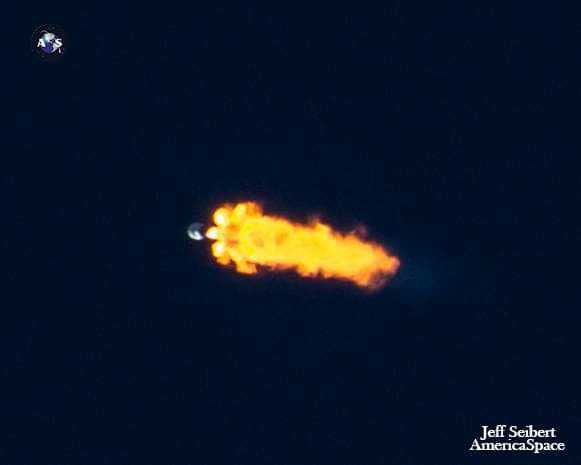
Just as Jerry Ross held onto his achievement as the first human to launch from Earth seven times for only a matter of weeks before it was tied by another astronaut, so SpaceX’s veteran B1049 Falcon 9 core will not rest long on its own record-setting laurels. On Friday morning, its sister B1051—which has already logged six flights since March 2019—is set to roar aloft again with a high-powered broadcasting satellite, bound for Geostationary Transfer Orbit (GTO).
Liftoff of the blackened and scorched core and its sparking second stage is targeted to occur no sooner than 11:21 a.m. EST Friday from Space Launch Complex (SLC)-40 at Cape Canaveral Air Force Station, Fla. It will be SpaceX’s 25th flight of the year.
Almost two decades ago, in April 2002, Ross became the first human in history to launch from Earth into space for a seventh occasion. Less than nine weeks later, fellow astronaut Franklin Chang-Diaz repeated the feat. As of today, no other human space explorer has rivaled their joint accomplishment. Two weeks ago, B1049 became the first Falcon 9 to log a seventh liftoff.

And on Friday, if all goes well, B1051 will tie this record and set one more of its own: becoming the first booster to launch five times in a single calendar year. Putting that into context, even in its pre-Challenger heyday, the frequent-flying (though infinitely complex) Space Shuttle did not achieve such impressive turnaround statistics.
First flown in March 2019 to deliver SpaceX’s inaugural Crew Dragon in an unmanned capacity from historic Pad 39A at the Kennedy Space Center (KSC) in Florida to the International Space Station (ISS), B1051 subsequently saw service to loft Canada’s three-satellite Radarsat Constellation Mission (RCM) from SLC-4E at Vandenberg Air Force Base, Calif., the following June. But it has been 2020 that this venerable core stage really hit its stride.

Between 29 January and 18 October, it flew no less than four times, placing 237 Starlink internet communications satellites and a pair of BlackSky rideshare payloads into orbit. In doing so, B1051 helped establish the Falcon 9’s credentials as the most-flown active operational U.S. launch vehicle, surpassing the United Launch Alliance (ULA) Atlas V.
It became the first core to fly four discrete missions in a single calendar year and on Friday will also become the first to fly five.

In readiness for its next launch, B1051 and a sparkling-new upper stage were trundled out of the Horizontal Integration Facility (HIF) on Monday and were put through a customary Static Fire Test of the nine Merlin 1D+ first-stage engines. “Static Fire Test complete,” SpaceX tweeted shortly thereafter. “Targeting Falcon 9 launch of SXM-7 for @SIRIUSXM from SLC-40 in Florida on Friday, 11 December.”
Weighing around 15,000 pounds (7,000 kg), SXM-7 is provided by the New York-headquartered SiriusXM Holdings, Inc., and will support its Digital Audio Radio Service (DARS). Contracts to build the satellite (and its twin, SXM-8, targeted for launch next year), were signed with Space Systems/Loral (SS/L)—now a subsidiary of Maxar Technologies—back in July 2016.

Both are based upon the SSL-1300 “bus” and will generate more than 20 kilowatts of electrical power and carry a large unfurlable S-band antenna reflector, capable of broadcasting to radios without the need for large dishes on the ground. When it enters operational service, SXM-7 will replace an earlier satellite, XM-3, which is now approaching the end of its lifetime, having been put into orbit way back in March 2005.
“SiriusXM provides an unparalleled variety of audio entertainment for radio listeners in North America,” said John Celli, then-president of SSL at the time of the July 2016 contract award. “We have a long history of working with SiriusXM to develop some of the world’s most advanced satellites, which broadcast to cars and radios for the home, office, and mobile devices. We are honored to be selected to build two additional satellites that will reinforce and augment the fleet’s capability.”

SXM-7 arrived at Cape Canaveral Air Force Station in mid-October, where it underwent functional testing and fueling, ahead of encapsulation aboard the Falcon 9. “SXM-7 will deliver the highest power density of any commercial satellite on-orbit,” noted Maxar, “sending more than 8,000 watts of content to the Continental U.S., Canada, Puerto Rico and the Caribbean, increasing the quality of signal for SiriusXM subscribers.”
Weather conditions for Friday’s morning’s opening launch attempt are expected to be 80-percent favorable, tempered by a risk of violating the Cumulus Cloud Rule.





